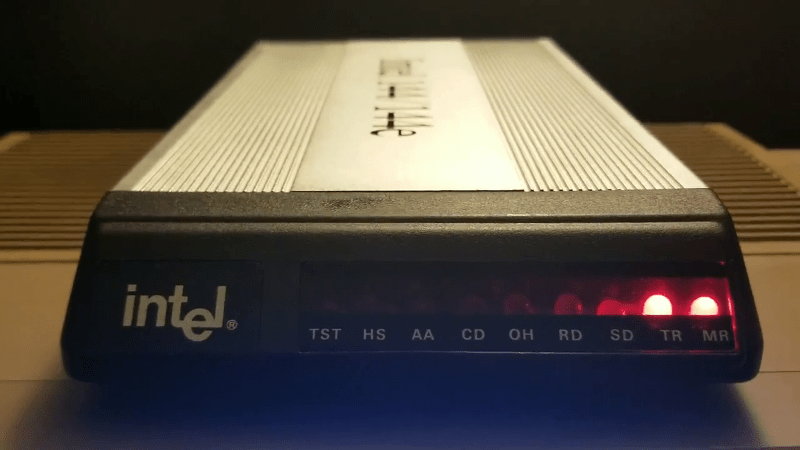Retrocomputers are fun, but ultimately limited in capability compared to modern hardware. One popular pursuit to rectify this is the connection of early home computers to the Internet. To that end, [que] built the Retromodem for the Commodore 64.
The build starts with a case from an Intel 14.4 modem. A little fast for the Commodore 64 era, but anachronism is charming when done tastefully. Inside is an Arduino with an ethernet module to handle the heavy lifting of carrying packets to the outside world. [que] took the time to wire up status LEDs for the proper vintage look, which really adds something to the project. They switch on and off to indicate the various settings on the modem – it’s great to see in the video below the break the “HS” LED light up when the baud rate is changed to a higher speed.
The project implements most of the Hayes command set, so you can interface with it over a serial terminal just like it’s 1983. [que] doesn’t go into too many details of how it’s all put together, but for the experienced code warrior it’s a project that could be whipped up in a weekend or two. For a more modern take, perhaps you’d like to hook your C64 up over Wifi instead?
















Holy crap, I just realized you could put an entire snapshot of the dial-up world from 1983 inside that box, and emulate calling any one of the BBS’s there (including the one I co-ran starting from 1981). I still have an archive of it; if it were not for the permissions involved I’d donate it to the cause.
A lot may have passed away, but that does remind me of that joke about reaching the end of the internet, as well as those big yellow internet phone books.
Those are actually more useful now than they were back in the day, because archive.org doesn’t have a subject search index, however, back in the day they were always 8 months to a year out of date, so it was always kinda like trying to order food with a 10 year old phone book during the rapid growth years.
While it’s not BBS there’s a similar service that’s displaying usenet as it was 30 years ago in real time, http://olduse.net/ so you can do a similar thing with old computers able to access usenet.
Even if you’re worried about the permissions of it, make sure you make an archive of your BBS and pass it along to Jason Scott (textfiles.com). That way, even if there’s not a publicly accessible version there’ll still be a copy for future generations to look at.
Needs some sort of audio playback capability so it can do the dial tone, the phone number digits you entered and then a pre-recorded modem squeal for the connection.
Seriously though, this is pretty cool.
BEEEEEEEEEEEEEEP
BIP BOOP BOOP BIP BIP BOOP BIP
SQUEAL
I think I remember why cable and DSL modem don’t make noise.
Because you can’t hear things in the megahertz or gigahertz range?
Dial-up modems had speakers so you could hear the progress. Get the ,one off hook and if no dial tone, someone else was using the phone, or the line was dead. You could hear the dialing, and then the ringing or busy signal. Then listen as the to modems negotiated. You might not be able to “read” those negotiations, but you got used to the sequence, and would notice if something was different.
An Ethernet connection doesn’t seem as complicated at the start. But there aren’t the convenient audio tones coming from the phone line.
Michael
Plus, it gives tech support endless amusement options: “Can you describe the noise your computer makes when you try to get online?”
My thoughts exactly!
Would be nice to get a .wav from the internet and have it play before connect just for that authentic touch. There should be way to compress the sound data as it was only FSK before 9600 BAUDot.
I bet people are now wondering just how old the AT command set is as it’s often used on GPS modules and 2G 3G GPRS modems as well.
PS: This is probably the coolest hack I have seen for some time.
Then someone comes along and hacks a refrigerator proving that’s the coolest.
Freezer…
http://telnetbbsguide.com/
The Telnet BBS Guide is the largest active listing of Dial-Up and Telnet accessible Bulletin Board Systems on the Internet! We list a total of 401 BBS and related systems with brief and detailed descriptions and a downloadable text-version listing suitable for listing on your BBS or for as a download for others to view and use.
Actually, can’t you probably do this with a WRT54G or something with serial port mod and one of the models that doesn’t have too tight RAM/ROM so you can set up terminal session with Links on it or something.
Holy shi- this actually happend? mad props man, damn.